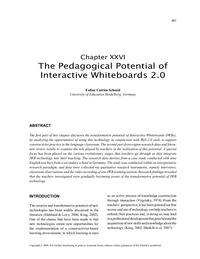The Pedagogical Potential of Interactive Whiteboards 2.0Euline Cutrim Schmid
Zu finden in: Handbook of Research on Web 2.0 and Second Language Learning (Seite 491 bis 505), 2008
  |
 |
 Diese Seite wurde seit 7 Jahren inhaltlich nicht mehr aktualisiert.
Unter Umständen ist sie nicht mehr aktuell.
Diese Seite wurde seit 7 Jahren inhaltlich nicht mehr aktualisiert.
Unter Umständen ist sie nicht mehr aktuell.
 Zusammenfassungen
Zusammenfassungen
 In this chapter, I will draw
upon the findings of a case study carried out in
a private German integrated school to discuss
how the IWB technology can be used as a useful
resource for the implementation of an activity-rich,
autonomy-enhancing, project-based approach to
language teaching.
In this chapter, I will draw
upon the findings of a case study carried out in
a private German integrated school to discuss
how the IWB technology can be used as a useful
resource for the implementation of an activity-rich,
autonomy-enhancing, project-based approach to
language teaching. This chapter discusses the transformative
potential of interactive whiteboard (IWB) technology
by considering two main factors: a) the
role played by teachers in the realization of this
potential and b) the IWB applications that create
new opportunities for transformative learning.
The main focus will be on how IWB technology
and WEB 2.0 tools can be combined to support
constructivist practice in the language classroom.
The term "IWB 2.0" (Wenger, 2007) has already
been coined to describe the possibilities of melding
IWB technology with Web 2.0 tools. However,
there is a need for more extensive discussion of
how this could be done in practice.
This chapter discusses the transformative
potential of interactive whiteboard (IWB) technology
by considering two main factors: a) the
role played by teachers in the realization of this
potential and b) the IWB applications that create
new opportunities for transformative learning.
The main focus will be on how IWB technology
and WEB 2.0 tools can be combined to support
constructivist practice in the language classroom.
The term "IWB 2.0" (Wenger, 2007) has already
been coined to describe the possibilities of melding
IWB technology with Web 2.0 tools. However,
there is a need for more extensive discussion of
how this could be done in practice. The first part of this chapter discusses the transformative potential of Interactive Whiteboards (IWBs), by analyzing the opportunities of using this technology in conjunction with Web 2.0 tools to support constructivist practice in the language classroom. The second part draws upon research data and literature review results to examine the role played by teachers in the realization of this potential. A special focus has been placed on the various evolutionary stages that teachers go through as they integrate IWB technology into their teaching. The research data derives from a case study conducted with nine English teachers from a secondary school in Germany. The study was conducted within an interpretative research paradigm, and data were collected via qualitative research instruments, namely interviews, classroom observations and the video recording of one IWB training session. Research findings revealed that the teachers investigated were gradually becoming aware of the transformative potential of IWB technology.
The first part of this chapter discusses the transformative potential of Interactive Whiteboards (IWBs), by analyzing the opportunities of using this technology in conjunction with Web 2.0 tools to support constructivist practice in the language classroom. The second part draws upon research data and literature review results to examine the role played by teachers in the realization of this potential. A special focus has been placed on the various evolutionary stages that teachers go through as they integrate IWB technology into their teaching. The research data derives from a case study conducted with nine English teachers from a secondary school in Germany. The study was conducted within an interpretative research paradigm, and data were collected via qualitative research instruments, namely interviews, classroom observations and the video recording of one IWB training session. Research findings revealed that the teachers investigated were gradually becoming aware of the transformative potential of IWB technology.
 Dieser Text erwähnt ...
Dieser Text erwähnt ...
 Personen KB IB clear | Marc Prensky , Lew Semjonowitsch Vygotsky | |||||||||||||||||||||||||||
 Fragen KB IB clear | Fördern interaktive Whiteboards das Lernen?
Führen interaktive Whiteboards zu vermehrtem Frontalunterricht? | |||||||||||||||||||||||||||
 Begriffe KB IB clear |  Interaktive Whiteboards Interaktive Whiteboards interactive whiteboard
, interactive whiteboard
,  LehrerIn LehrerIn teacher
, teacher
,  Lernen Lernen learning
, learning
,  Sprache Sprache language
, Sprachenlernenlanguage learning language
, Sprachenlernenlanguage learning
| |||||||||||||||||||||||||||
 Bücher |
| |||||||||||||||||||||||||||
 Texte |
|
 Dieser Text erwähnt vermutlich nicht ...
Dieser Text erwähnt vermutlich nicht ... 
 Nicht erwähnte Begriffe | Bildung, Fremdsprache, Fremdsprachenlernen, Kinder, Schule, Unterricht |
 Tagcloud
Tagcloud
 Zitationsgraph
Zitationsgraph
 Zitationsgraph (Beta-Test mit vis.js)
Zitationsgraph (Beta-Test mit vis.js)
 Anderswo finden
Anderswo finden
 Volltext dieses Dokuments
Volltext dieses Dokuments
 Anderswo suchen
Anderswo suchen 
 Beat und dieser Text
Beat und dieser Text
Beat hat Dieser Text während seiner Zeit am Institut für Medien und Schule (IMS) ins Biblionetz aufgenommen. Beat besitzt kein physisches, aber ein digitales Exemplar. Eine digitale Version ist auf dem Internet verfügbar (s.o.). Es gibt bisher nur wenige Objekte im Biblionetz, die dieses Werk zitieren.











 , 1009 kByte;
, 1009 kByte;  Link unterbrochen? Letzte Überprüfung: 2021-03-21 Letzte erfolgreiche Überprüfung: 2015-02-28)
Link unterbrochen? Letzte Überprüfung: 2021-03-21 Letzte erfolgreiche Überprüfung: 2015-02-28)  Biblionetz-History
Biblionetz-History